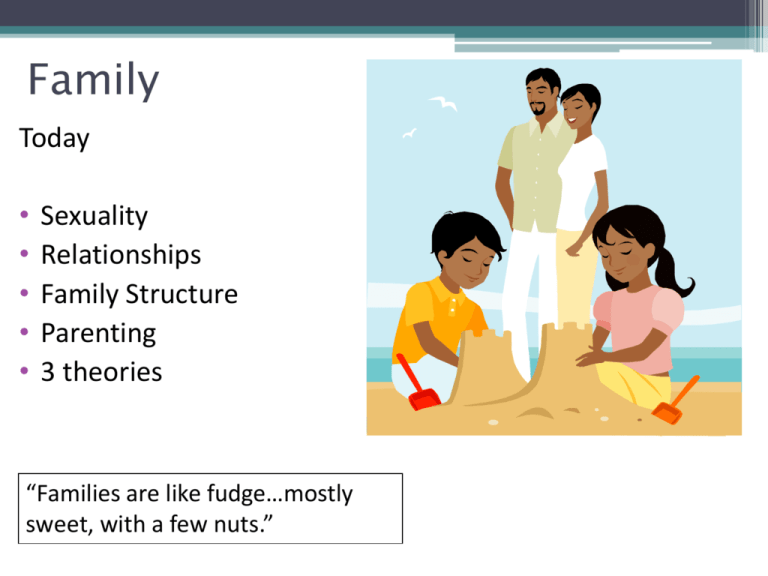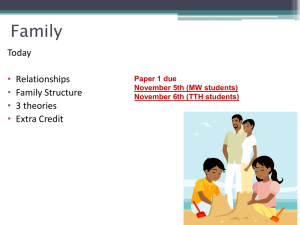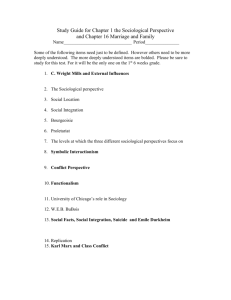Family - 2015 Intro to Sociology
advertisement

Family Today • • • • • Sexuality Relationships Family Structure Parenting 3 theories “Families are like fudge…mostly sweet, with a few nuts.” Sexuality Workplace Marriage Safety Sexuality and Laws Many states do not prohibit employment discrimination on the basis of sexual orientation and gender identity. ENDA The Employment Non-Discrimination Act (ENDA) Proposed bill to make it illegal nationally Marriage recognition Provides same sex couples: -employment based health benefits -right to sue for wrongful death -ability to make medical decisions 14 states in the U.S. that recognize same-sex marriage (Oct 2013) 36 states in the U.S. that recognize same-sex marriage (2015) Source: Same-sex marriage in the United States" by Lokal_Profil. Licensed under CC BY-SA 2.5 via Wikimedia Commons http://commons.wikimedia.org/wiki/File:Samesex_marriage_in_the_United_States.svg#/media/File:Sa me-sex_marriage_in_the_United_States.svg Same-Sex Marriage Globally 2014 Harassment in Schools Survey of LGBT students ages 13–20 -64% feeling unsafe, verbally harassed -38% physical harassment 2010 Hate Crimes Murder of : Matthew Shepard college student, Wyoming 1998 2009: federal protection for gay individuals under hate-crime laws Hate crimes = Harsher punishments for crimes motivated by bias (race, religion) Extra Credit Power Point (or Prezi.com) Option: Sociologists to Know Extra Credit 5 minutes Select a sociologist (sign up in class) 4 points possible Samples and details on website Present April 8th E-mail me PowerPoint by April 7th 11:00pm Finding your significant other 4 factors sociologists are interested in 1. Propinquity (spatial nearness) 2. Homogamy: tendency to chose a mate who is similar to you 3. Heterogamy: choosing a mate that is different than you Factors: hobbies, education, personality traits, spending habits, age, political beliefs, etc. 4. Endogamy: choosing a mate of the same racial, ethnic, or religious background 5. Exogamy: choosing a mate outside of your race, ethnicity, religion Defining Family • Social institution found in every human society • Two or more people, who consider themselves related by blood, marriage, or adoption Defining Family • Nuclear family: Parents and their children • Extended family: parents, children, other kin What changes do you think have occurred in the structure of families in the United States since the 1950’s? Has divorce increased, decreased, or stayed the same since the 1980’s? Number of divorces per 1,000 married women, age 15 and older Source: The National Marriage Project, State of Our Unions, 2010. Source: The National Marriage Project, State of Our Unions, 2010. Pros and Cons of Changes in Family Structure Answer questions in groups of 1-4 Changes in structures of U.S. families: 1. Delayed childbearing •Today 1 in 5 women are having their first baby after age 35 What are positive and negative aspects of this change? Changes in U.S. family structures 2. Not having children 14% of U.S. married couples never have children. Why? •Expenses •Career focus •Unstable relationships •Inability to have children Changes in U.S. family structures 3. Increased employment of married mothers 59% of married U.S. couples depend on two incomes About one in five children is cared for in day care centers. What are positive and negative aspects of this change? Nannies have become popular among upper-middle class parents. What are positive and negative aspects of this change? Cosby Show Changes in U.S. family structures 4. Increase in the number of children being raised by grandparents 6.5 million children are being raised by grandparents or other relatives (U.S. Census Bureau) What are positive and negative aspects of this change? Changes in U.S. family structures 5. Increased divorce and blended families Modern Family Changes in U.S. family structures 6. Increased single-parent families One on One (Single dad and teenage daughter) Changes in U.S. family structures 7. Older age at 1st marriage Friends Sex and The City Changes in structures of U.S. families: Older age at 1st marriage U.S. men and women are staying single longer 1970 average age at marriage 2010 average age at marriage Men: 23 Men : 28 Women: 21 Women: 26 Changes in U.S. family structures 8. Increased interracial families The Willis Family from the TV Show The Jeffersons Changes in U.S. family structures 9. Increased cohabitation-couple living together that is not married Grey’s Anatomy Which states do you think have the most cohabitation? least? Most unmarried partners: California, Alaska Least unmarried partners: Utah at 4% and Alabama 5% Changes in U.S. family structures 10. Less people getting married. Why? 1.Marriage must now compete with school career living with a partner having children outside of marriage self-fulfillment 2. Less of a need to marry 3. Time and money - children 4. Fearful of commitments and constraints Other changes U.S. family structure • Increased births to unmarried women • Increase in families with same-sex parents • Increase in families with adopted children Has teenage pregnancy increased, decreased, or stayed the same since 1990’s? Teenage pregnancy has decreased Source: Center for Disease Control and Prevention http://www.cdc.gov/nchs/products/hestats.htm Parenting Punishment = penalty for misbehavior Discipline= method of teaching a child right from wrong View SuperNanny Clip http://www.youtube.com/watch?v=_YQpbzQ6gzs Parenting: Discipline Techniques 1. Be a positive role model. 2. Set rules and consequences. 3. Encourage and reward good behavior. 4. Create charts. 5. Give time-outs. 6. Spanking Which of these techniques do you think are effective? Which do you think are ineffective? Parenting Amy Chua’s article “Why Chinese Mothers are Superior” Underline 3 points that you agree or disagree with Underline any parenting techniques that you experienced or use as a parent 1. What did you underline and why 2. Do you agree with the author’s parenting style? Why or why not? 3. What parenting techniques do you think are best? Chua family From Ms. Chua's album: 'Mean me with Lulu in hotel room... with score taped to TV!' Structural Functionalist Perspective Family is the back bone of society – Replenishes population – Socializes children – Provides emotional and physical care Conflict Perspective Focuses on power distribution in marriages • Why do women take husbands last name? • Why do children take father’s last name? Symbolic Interactionist Perspective Look at social meanings of divorce, single parenthood, and cohabitation • “Visitation rights” • “Single mom” • “Living in sin” Coming up • Family: read assigned textbook pages • Sign up for extra credit option • Read article Why Chinese Mothers are Superior and prepare to discuss 3 points from the article Papers that earned 15/15: 1. Followed the scoring rubric provided on the website and discussed in class 2. Answered the question with specific detailed examples (from research studies, history, news, world events) 3. Did not have errors in spelling, grammar, or punctuation 4. Demonstrated a strong understanding of the concept 5. Introduction had a strong, clear thesis previewing the 3 examples Choice A: Norms. Define norms, mores, and folkways as defined in your text. Research and provide three examples of norms that were once mores in our society, but over time have become folkways (or the other way around). Provide an analysis of why you think this change occurred. Choice B: Subcultures. Define sub-cultures and counter cultures. Research and provide three examples of sub-cultures or counter cultures in American society. Why do they fit the definition of a sub-culture or counter-culture? What are some of the norms and values of each? Choice C: Race 100 years ago, sociologist W.E.B Du Bois said “The problem of the 20th century is the problem of the color line.” What is racism? Why is W.E.B Du Bois an important sociologist? Research and describe two modern day (recent) events related to racism. Choice D: Prejudice: Describe three of the four sociological approaches to explaining prejudice (Cultural Transmission, Group Identification Theory, Personality Theories, Frustration-aggression hypothesis) Research and provide a real-life example of each (from history, news, or one from personal experience, be specific and detailed). Which of these theories do you feel best explains discriminatory behaviors, why? Choice E: Illegal Immigration Research and analyze illegal immigration through each of the sociological perspectives. Conflict theory, Structural Functionalism, Symbolic Interactionism Extra Credit Important Sociologists • 5 minute Power Point Presentation • Select a sociologist. Describe the following: brief background of their life, 2 major contributions to sociology, how is their work relevant today? • 4 points possible • Choose the sociologist in class today by signing up About Research Paper 15 points 3 pages typed Use scoring RUBRIC, this is how I grade the paper Use the OUTLINES on the website








